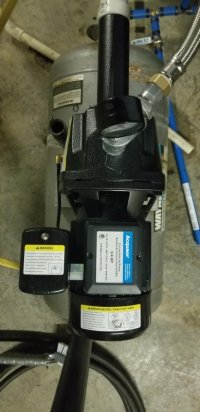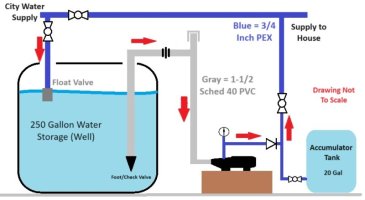WOP31
New Member
Hello all, and thanks for having me. I have done some poking around and found some good info on the forums but have not been able to find anyone with the same issue that I am having.
I have just redone my cistern set up in my basement and having an issue with my pump. It will build pressure and it cuts out at 60 psi, as it should. But when it cuts out the pump acts like it loses pressure, then cuts on again, then off, then on then off, etc.... It will then repeatedly cut in and out as it "Bounces" off of 60psi. All testing has been done with the valve from the pump/accumulator to the house closed, so I am only pressurizing the accumulator tank. The house is currently running on just city pressure as the tank/pump is bypassed.
I have included a picture of my set-up. On the advice of a plumber friend, I am going to add a valve on the output of the accumulator tank so that it can be isolated.
Aside from adding in a valve at the accumulator and adding the check valve on the output of the pump the system is the same as was previously there.
NOTE: The reason for this set up is that the city water supply pressure is very low, and it is unable to supply the volume drawn by the pump, so the previous owner put the cistern tank in the basement.

I have just redone my cistern set up in my basement and having an issue with my pump. It will build pressure and it cuts out at 60 psi, as it should. But when it cuts out the pump acts like it loses pressure, then cuts on again, then off, then on then off, etc.... It will then repeatedly cut in and out as it "Bounces" off of 60psi. All testing has been done with the valve from the pump/accumulator to the house closed, so I am only pressurizing the accumulator tank. The house is currently running on just city pressure as the tank/pump is bypassed.
I have included a picture of my set-up. On the advice of a plumber friend, I am going to add a valve on the output of the accumulator tank so that it can be isolated.
Aside from adding in a valve at the accumulator and adding the check valve on the output of the pump the system is the same as was previously there.
NOTE: The reason for this set up is that the city water supply pressure is very low, and it is unable to supply the volume drawn by the pump, so the previous owner put the cistern tank in the basement.



